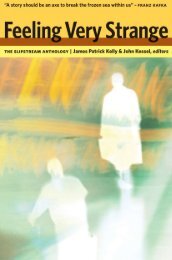The Curse of the Wer.. - Site de Thomas - Free
The Curse of the Wer.. - Site de Thomas - Free
The Curse of the Wer.. - Site de Thomas - Free
You also want an ePaper? Increase the reach of your titles
YUMPU automatically turns print PDFs into web optimized ePapers that Google loves.
76 THE CURSE OF THE WEREWOLF<br />
<strong>the</strong> conventions <strong>of</strong> psychological characterization typical <strong>of</strong> <strong>the</strong> realist<br />
novel, Endore had <strong>de</strong>veloped Bertrand (based upon Sergeant Bertrand<br />
<strong>of</strong> Paris) as a roun<strong>de</strong>d character with a flaw — lycanthropy. This approach<br />
was emulated in <strong>The</strong> <strong>Wer</strong>ewolf <strong>of</strong> London, with <strong>the</strong> film tracing<br />
Dr Wilfrid Glendon’s passage through confusion, <strong>de</strong>nial, acceptance <strong>of</strong><br />
responsibility for <strong>the</strong> mysterious killings, abortive attempts to control<br />
or cure his condition, spiritual torment, <strong>de</strong>sperate efforts to warn<br />
potential victims <strong>of</strong> <strong>the</strong>ir danger, <strong>de</strong>spair, and a tragic <strong>de</strong>ath. Subsequently,<br />
werewolf films have typically explored <strong>the</strong> mental anguish<br />
<strong>de</strong>picted by Hull’s 1935 prototype. This trend was crystallized with <strong>the</strong><br />
1941 release <strong>of</strong> Universal’s <strong>The</strong> Wolf Man, scripted by Curt Siodmak,<br />
a close friend <strong>of</strong> Endore’s.<br />
<strong>The</strong> Wolf Man is Larry Talbot, played by Creighton Chaney, billed<br />
as Lon Chaney Jnr because he was <strong>the</strong> son <strong>of</strong> Lon Chaney, <strong>the</strong> famous<br />
horror actor <strong>of</strong> <strong>the</strong> 1930s 31 (Figure 8). According to <strong>the</strong> film’s narrative,<br />
Larry has spent most <strong>of</strong> his adult life in America and is reunited with<br />
his aristocratic fa<strong>the</strong>r in Wales following his bro<strong>the</strong>r’s <strong>de</strong>ath. Bitten by<br />
a Gypsy werewolf, he becomes cursed with lycanthropy, causing havoc<br />
in his ancestral village. <strong>The</strong> years following <strong>the</strong> film’s release in 1941<br />
witnessed <strong>the</strong> consistent return <strong>of</strong> <strong>the</strong> Wolf Man character (played each<br />
time by Chaney) in a variety <strong>of</strong> monster-assembly movies, as well as a<br />
number <strong>of</strong> imitations <strong>of</strong> <strong>the</strong> werewolf <strong>the</strong>me by o<strong>the</strong>r studios. 32 In<strong>de</strong>ed,<br />
<strong>the</strong> Wolf Man quickly became as popular as <strong>the</strong> Frankenstein monster,<br />
eclipsing Dracula and enjoying <strong>the</strong> most screen time in <strong>the</strong> films he<br />
shared with o<strong>the</strong>r monsters. 33<br />
Endore’s <strong>The</strong> <strong>Wer</strong>ewolf <strong>of</strong> Paris, <strong>The</strong> <strong>Wer</strong>ewolf <strong>of</strong> London, <strong>The</strong><br />
Wolf Man and its sequels forged a new syn<strong>the</strong>sis <strong>of</strong> mythologies about<br />
lycanthropy that would transform <strong>the</strong> werewolf into a powerful new<br />
icon <strong>of</strong> <strong>the</strong> twentieth century. In<strong>de</strong>ed, because <strong>the</strong> werewolf lacks a<br />
generating text as famous as Mary Shelley’s Frankenstein, Stoker’s<br />
Dracula, or even Robert Louis Stevenson’s <strong>The</strong> Strange Case <strong>of</strong> Dr<br />
Jekyll and Mr Hy<strong>de</strong>, twentieth-century authors <strong>of</strong> werewolf stories,<br />
ra<strong>the</strong>r than referring to a single nineteenth-century literary text for<br />
inspiration, have consistently allu<strong>de</strong>d to <strong>the</strong> cluster <strong>of</strong> texts which<br />
<strong>de</strong>fined <strong>the</strong> subgenre in <strong>the</strong> 1930s and 1940s. Yet, ironically, <strong>the</strong> ico-





